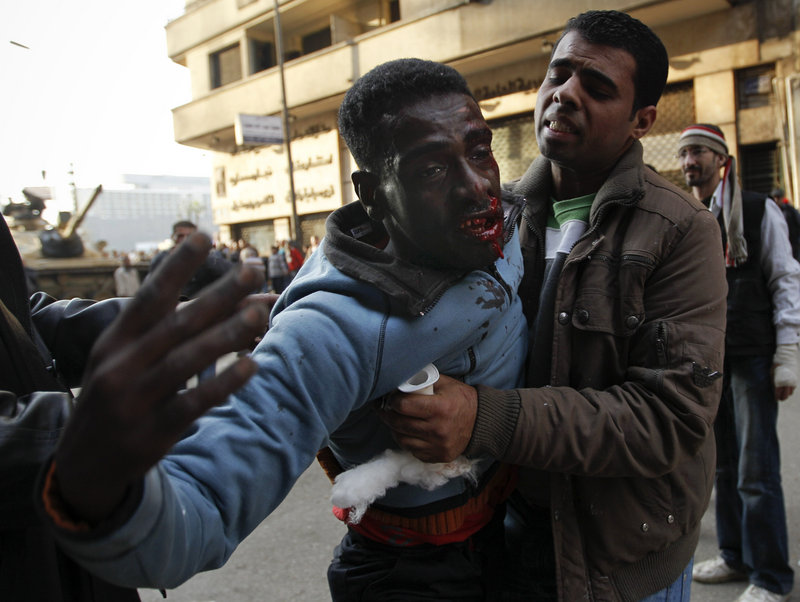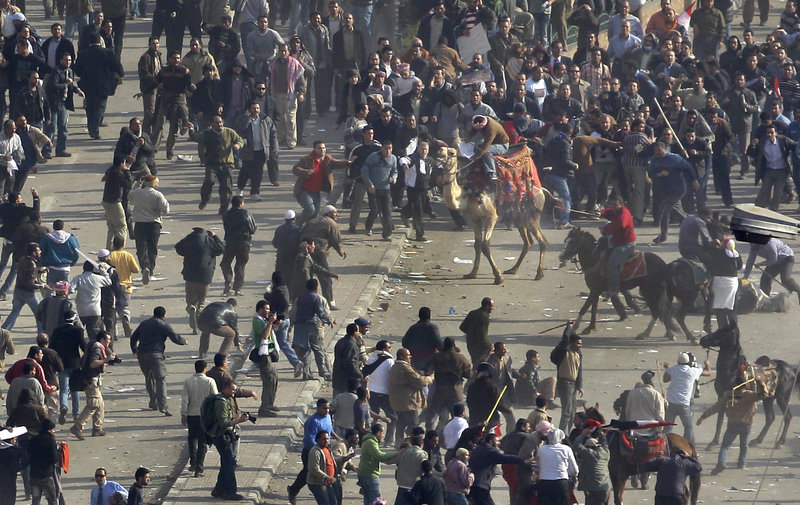CAIRO — Bursts of heavy gunfire rained into Cairo’s Tahrir Square before dawn today, killing at least three anti-government demonstrators among crowds trying to hold the site after a dramatic assault hours earlier by supporters of President Hosni Mubarak, according to a protest organizer.
Sustained bursts of automatic weapons fire and powerful single shots rattled into the square starting at around 4 a.m. and continued for more than two hours.
Protest organizer Mustafa el-Naggar said he saw the bodies of three dead protesters being carried toward an ambulance. He said the gunfire came from at least three locations in the distance and that the Egyptian military, which has ringed the square with tank squads for days to try to keep some order, did not intervene.
Footage from AP Television News showed one tank spreading a thick smokescreen along a highway overpass just to the north of the square in an apparent attempt to deprive attackers of a high vantage point. The two sides seemed to be battling for control of the overpass, which leads to a main bridge over the Nile.
In the darkness, groups of men hurled firebombs and rocks along the bridge, where a wrecked car sat engulfed in flames. Others dragged two apparently lifeless bodies from the area.
Throughout Wednesday, Mubarak supporters had charged into the square on horses and camels brandishing whips and clubs, while others rained firebombs from rooftops in what appeared to be an orchestrated assault against protesters trying to topple Egypt’s leader of 30 years. Three people died in that earlier violence and 600 were injured.
The protesters accused Mubarak’s regime of unleashing a force of paid thugs and plainclothes police to crush their unprecedented nine-day-old movement, a day after the 82-year-old president refused to step down. The protesters showed off police ID badges that they said were wrested from their attackers. Some government workers said their employers ordered them into the streets.
Mustafa el-Fiqqi, a top official from the ruling National Democratic Party, told The Associated Press that businessmen connected to the ruling party were responsible for what happened.
The notion that the state may have coordinated violence against protesters, who had kept a peaceful vigil in Tahrir Square for five days, prompted a sharp rebuke from the Obama administration.
“If any of the violence is instigated by the government, it should stop immediately,” said White House press secretary Robert Gibbs.
The clashes marked a dangerous new phase in Egypt’s upheaval: the first significant violence between government supporters and opponents. The crisis took a sharp turn for the worse almost immediately after Mubarak rejected the calls for him to give up power or leave the country, stubbornly proclaiming he would die on Egyptian soil.
His words were a blow to the protesters. They also suggest that authorities want to turn back the clock to the tight state control enforced before the protests began.
Mubarak’s supporters turned up on the streets Wednesday in significant numbers for the first time.
Some were hostile to journalists and foreigners. Two Associated Press correspondents and several other journalists were roughed up in Cairo. State TV had reported that foreigners were caught distributing anti-Mubarak leaflets, apparently trying to depict the movement as foreign-fueled.
After midnight, 10 hours after the clashes began, the two sides were locked in a standoff at a street corner, with the anti-Mubarak protesters hunkered behind a line of metal sheets hurling firebombs back and forth with government backers on the rooftop above. The rain of bottles of flaming gasoline set nearby cars and wreckage on the sidewalk ablaze.
The scenes of mayhem were certain to add to the fear that is already running high in this capital of 18 million people after a weekend of looting and lawlessness and the escape of thousands of prisoners from jails during the chaos.
Soldiers surrounding Tahrir Square fired occasional shots in the air throughout the day but did not appear to otherwise intervene in the fierce clashes, and no uniformed police were seen. Most of the troops took shelter behind or inside the armored vehicles and tanks stationed at the entrances to the square.
The two sides pummeled each other with chunks of concrete and bottles at each of the six entrances to the sprawling plaza, where 10,000 anti-Mubarak protesters tried to fend off more than 3,000 attackers who besieged them. Some on the pro-government side waved machetes, while the square’s defenders filled the air with a ringing battlefield din by banging metal fences with sticks.
Egyptian Health Minister Ahmed Sameh Farid said three people died and at least 611 were injured in Tahrir Square on Wednesday.
Wednesday’s events suggest the regime aims to put an end of the unrest to let Mubarak shape the transition as he chooses over the next months. Mubarak has offered negotiations with protest leaders over democratic reforms, but they have refused any talks until he steps down.
Send questions/comments to the editors.




Success. Please wait for the page to reload. If the page does not reload within 5 seconds, please refresh the page.
Enter your email and password to access comments.
Hi, to comment on stories you must . This profile is in addition to your subscription and website login.
Already have a commenting profile? .
Invalid username/password.
Please check your email to confirm and complete your registration.
Only subscribers are eligible to post comments. Please subscribe or login first for digital access. Here’s why.
Use the form below to reset your password. When you've submitted your account email, we will send an email with a reset code.